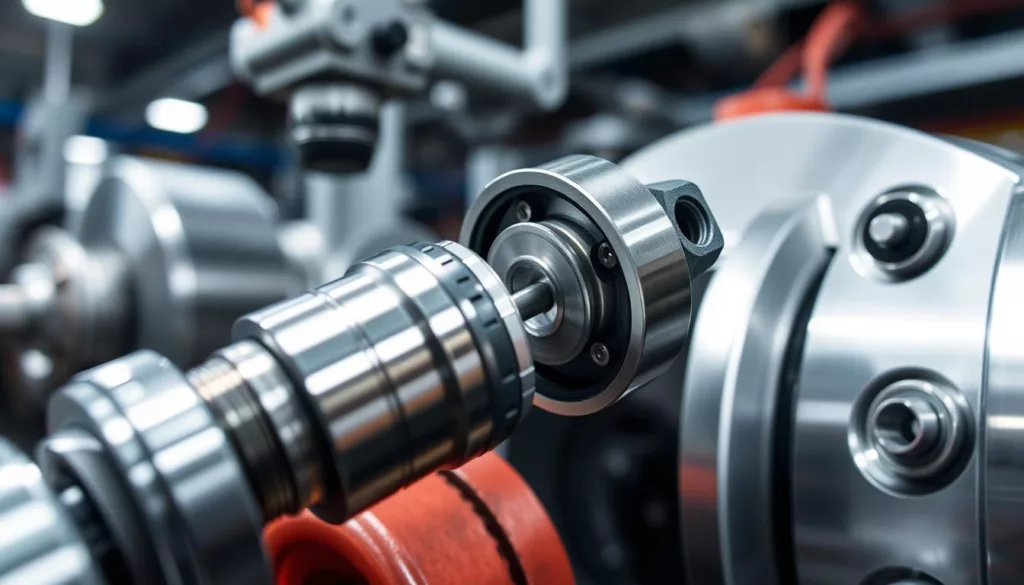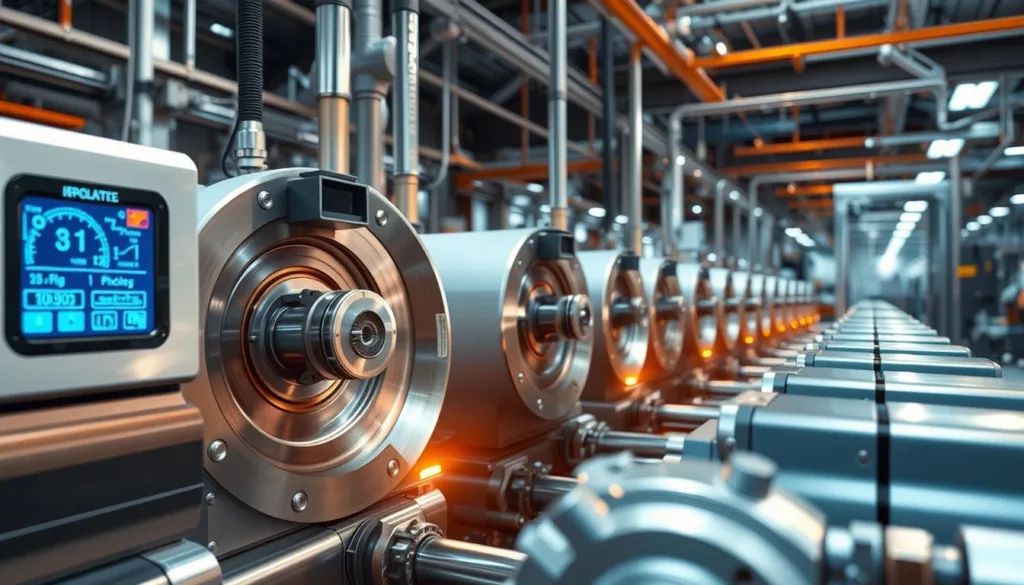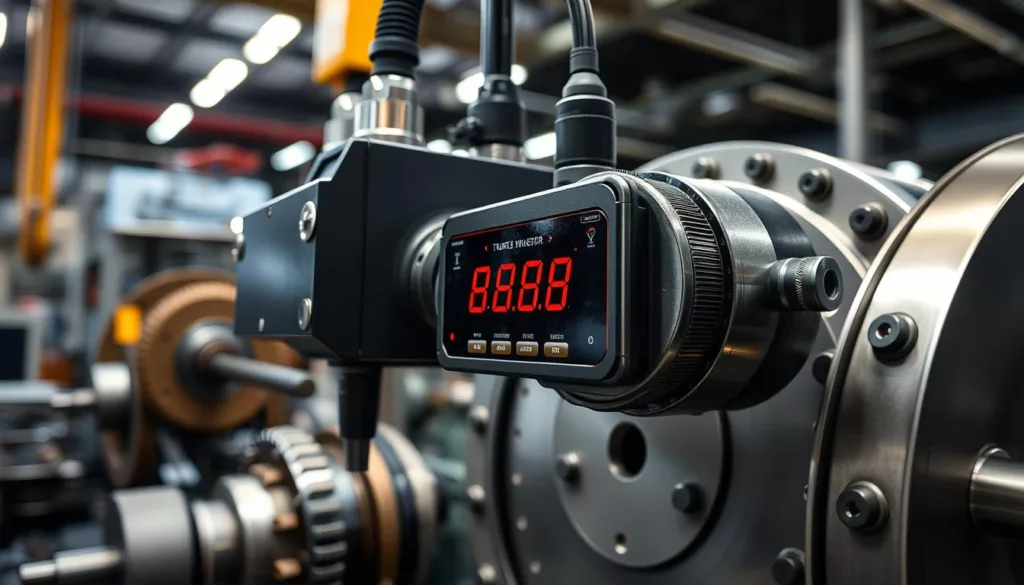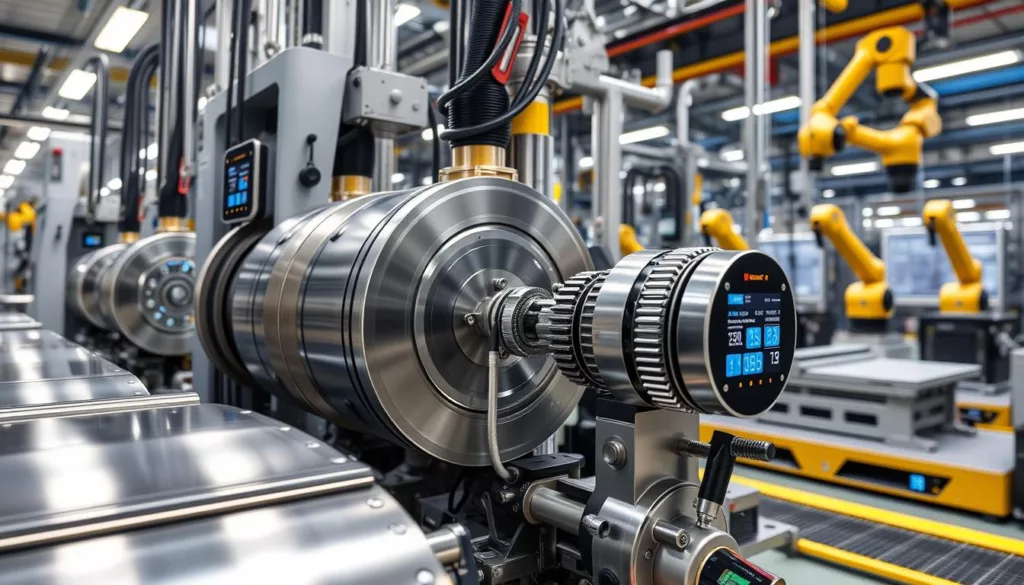In today’s fast-paced manufacturing world, knowing the exact torque in rotating machinery is key. Torque sensors are vital for this, giving workers the data they need to keep their equipment running smoothly.
This guide will cover the basics and uses of torque sensors in factories. It’s aimed at helping engineers, technicians, and buyers make smart choices. We’ll look at everything from the basics of torque to the newest sensor tech. This will help factories run better and more efficiently.
Key Takeaways
- Torque sensors are key for checking and improving rotating machinery in factories.
- It’s important to know how torque measurement works and what makes up industrial torque sensors.
- Installing, integrating, and calibrating torque sensors right is essential for getting accurate data and keeping equipment running well.
- Systems that monitor in real-time and collect data can help improve maintenance and keep equipment running longer.
- New tech in torque sensors, like IoT and predictive maintenance, helps factories move towards Industry 4.0.
Understanding Industrial Torque Measurement Fundamentals
At the heart of efficient factory machinery lies the ability to precisely monitor and measure torque. Precision torque sensors for manufacturing play a key role. They ensure the accuracy and reliability of rotating equipment, from punching presses to assembly lines. Let’s explore the fundamental principles and components that enable industrial torque measurement.
Basic Principles of Torque Sensing Technology
Torque sensors rely on the physical phenomenon of deformation to measure twisting force. They use strain gauges or other sensing elements. These elements convert mechanical strain into an electrical signal, allowing for precise torque quantification.
Key Components of Industrial Torque Sensors
- Sensing element: The core component that detects and transduces the mechanical strain into an electrical output, such as resistance changes or voltage signals.
- Signal conditioning: Electronic circuitry that amplifies, filters, and processes the raw sensor output to provide a usable, calibrated torque measurement.
- Mechanical design: The housing, bearings, and mounting interfaces that protect the sensing components and enable secure installation in the factory machinery.
Measurement Units and Standards
Industrial torque sensors measure torque in units of Newton-meters (N·m) or pound-feet (lb-ft). These units follow established international standards. This ensures consistent and comparable torque measurements across various applications and industries.
| Measurement Unit | Conversion |
|---|---|
| Newton-meters (N·m) | 1 N·m = 0.7376 lb-ft |
| Pound-feet (lb-ft) | 1 lb-ft = 1.356 N·m |
By understanding these fundamental principles and components, factory managers and engineers can choose the right torque monitoring solutions. This ensures optimal performance and efficiency in their production processes.
Types of Torque Sensors for Rotating Equipment
Choosing the right torque sensor is key for monitoring and controlling rotating machinery in factories. There are many torque sensing technologies available, each with its own benefits and drawbacks. Let’s look at the main types of torque sensors used in rotating equipment.
Strain Gauge Torque Sensors
Strain gauge torque sensors are a common choice for rotating machinery. They measure the small changes in the shaft or coupling caused by torque. These sensors are known for their high accuracy, good consistency, and ability to work well in tough environments. They’re often used for rotating equipment torque control.
Magnetoelastic Torque Sensors
Magnetoelastic torque sensors work by changing the magnetic properties of a material when it’s stressed. They can be put on without touching the shaft, making them great for torque sensing for factory automation. They’re reliable and work well at high speeds.
Optical Torque Sensors
Optical torque sensors use fiber optic tech to measure shaft twisting or deformation. They turn mechanical movement into digital signals, giving high precision and quick responses. These sensors are good in places with lots of electromagnetic interference (EMI) or where explosion-proofing is needed.
| Sensor Type | Strengths | Limitations |
|---|---|---|
| Strain Gauge | High accuracy, good repeatability, industrial-grade durability | Require direct shaft access, susceptible to environmental factors |
| Magnetoelastic | Non-contact installation, high-speed capability, EMI immunity | Potential magnetic interference, limited torque range |
| Optical | Precision, fast response, EMI/explosion-proof protection | Higher cost, complex installation requirements |
When picking a torque sensor for your rotating equipment, think about what you need, where it will be used, how it will be installed, and the cost. Knowing the good and bad of each sensor helps you choose the best one for your factory’s machinery.
Installation and Integration in Factory Settings
Adding torque sensors to a factory needs careful planning. You must think about how to mount them, connect them electrically, and calibrate them. By doing this right, factories can get precise torque readings. This helps their machines work better.
Mounting Requirements and Best Practices
Mounting torque sensors correctly is key to getting good readings. You need the right parts, a secure hold, and the sensor must be aligned with the shaft. Our experts say to follow the maker’s advice and use the right tools to avoid mistakes.
Electrical Integration Guidelines
Connecting the sensors electrically smoothly is important. You have to pick the right cables, ensure good grounding, and shield against interference. Our team offers detailed advice on setting up the electrical connections to make your torque sensing work well.
Calibration Procedures
Keeping the sensors accurate means regular checks. We suggest a thorough calibration plan, including the first setup, testing, and updates. Sticking to standards and maker’s tips helps your system work at its best and keeps data reliable.
| Mounting Requirements | Electrical Integration | Calibration Procedures |
|---|---|---|
| Secure attachment | Cable selection | Initial setup |
| Proper alignment | Grounding and shielding | Baseline testing |
| Adherence to manufacturer guidelines | Minimizing electromagnetic interference | Periodic recalibration |
“Proper installation and integration of torque sensors is essential for achieving accurate and reliable dynamic torque sensing in factories.”
Torque Sensors for Rotating Machinery in Factories: Applications and Benefits
Torque sensors are key tools in monitoring and improving rotating machinery in many industries. They help in the automotive and aerospace sectors by giving insights into equipment health and efficiency.
One main use of torque sensors is in torque load monitoring in factory equipment. They measure the torque loads on parts like shafts and bearings. This helps plant managers spot problems early, avoiding expensive repairs and keeping equipment running smoothly.
In manufacturing, torque sensors are used to check the quality of assembly. They measure industrial torque accurately, ensuring parts are tightened correctly. This prevents failures and keeps products strong.
| Industry | Application | Benefits |
|---|---|---|
| Automotive | Monitoring engine component assembly | Improved quality control, reduced warranty claims |
| Aerospace | Monitoring engine and landing gear maintenance | Enhanced safety, prolonged equipment lifespan |
| Manufacturing | Monitoring assembly line processes | Increased efficiency, reduced downtime |
Using torque sensing technology brings many benefits to factories. It improves quality, efficiency, and cuts maintenance costs. As factories move towards Industry 4.0, real-time torque monitoring will be key to boosting productivity and profits.
Real-time Monitoring and Data Collection Systems
The manufacturing world is changing fast. Precision torque sensors for manufacturing are key to keeping up. They help factories run better, saving time and money.
Data Acquisition Methods
Torque sensors are vital for collecting data. They give real-time info on how factory machines are doing. This info is sent to central systems for easy tracking.
Analysis Tools and Software Solutions
Advanced tools are needed to make sense of the data from factory machinery torque monitoring. These tools help see patterns and trends. This way, factories can improve how they work and save on costs.
Performance Tracking Metrics
- Torque output and consistency
- Vibration and bearing health
- Energy consumption and efficiency
- Asset utilization and downtime
Tracking these metrics helps factories understand their machines better. This knowledge leads to better performance and more savings.
“Integrating torque sensors with real-time monitoring and data collection systems is a game-changer for modern factories, enabling data-driven decision-making and optimized machinery performance.”
| Metric | Description | Benefits |
|---|---|---|
| Torque Output | Measures the actual torque generated by rotating equipment | Ensures optimal power transmission and productivity |
| Vibration Analysis | Monitors the vibration patterns of machinery components | Identifies and fixes issues before they get worse |
| Energy Efficiency | Tracks the energy consumption of rotating equipment | Helps use less energy and cut costs |
| Asset Utilization | Measures the overall effectiveness and uptime of machinery | Increases productivity and boosts profits |
Maintenance and Troubleshooting Guidelines
Keeping rotating equipment torque control systems accurate and reliable is key for efficient factory automation and torque sensing for factory automation. To keep your dynamic torque sensors precise, follow these maintenance and troubleshooting tips.
Preventive Maintenance Practices
- Regularly check sensor parts for wear or damage.
- Calibrate torque sensors every 6-12 months as the maker suggests.
- Ensure sensor mounts and cables are secure and clean.
- Lubricate moving parts to reduce friction and keep things running smoothly.
Troubleshooting Common Issues
Having trouble with your rotating equipment torque control system? Try these steps:
- Look at the sensor’s power and signal connections for any issues or loose wiring.
- Check if the sensor’s calibration is correct by comparing it to a known standard.
- Make sure the sensor is mounted right and not loose.
- Check if the sensor’s environment is within the right temperature, humidity, and vibration limits.
| Common Issue | Possible Causes | Recommended Actions |
|---|---|---|
| Inaccurate torque readings | – Sensor calibration drift – Mounting issues – Electrical interference |
– Recalibrate the sensor – Inspect and tighten the mounting – Ensure proper shielding and grounding |
| Unstable or fluctuating readings | – Mechanical vibrations – Electrical noise – Sensor damage |
– Isolate the sensor from vibrations – Implement signal filtering or conditioning – Replace the sensor if damaged |
| No output or signal loss | – Power supply issues – Wiring or connector problems – Sensor failure |
– Check the power source and connections – Inspect the wiring and replace if necessary – Contact the manufacturer for sensor replacement |
By following these guidelines, your rotating equipment torque control systems will keep working well. This ensures accurate torque sensing for factory automation, improving your production and keeping quality high.
“Proactive maintenance is the key to maximizing the lifespan and performance of your dynamic torque sensors.”
Advanced Features and Industry 4.0 Integration
In today’s fast-paced factories, torque sensors for rotating machinery are becoming key to unlocking new levels of efficiency and productivity. These advanced features and Industry 4.0 integration are changing how factories work. They are making operations more efficient and productive.
IoT Connectivity Options
The Industrial Internet of Things (IIoT) has made it easier for torque transducers to connect with factory systems. This connection allows for real-time monitoring and data collection. It also enables remote diagnostics, helping factories make better decisions and plan maintenance ahead of time.
Predictive Maintenance Capabilities
Using advanced torque sensing technology in factories helps with predictive maintenance. This technology keeps equipment running smoothly and reduces downtime. It watches torque data closely, spotting problems early to prevent unexpected stops.
Smart Factory Implementation
Integrating torque sensing in factories and torque transducers for rotating systems is essential for smart factories. These sensors work with data platforms and analytics to improve production and quality. They help factories run better, making them more efficient and effective.
“The future of industrial automation lies in the seamless integration of cutting-edge sensor technologies and intelligent data management systems. Torque sensors play a vital role in this transition, enabling factories to operate with unprecedented efficiency and agility.”
Cost Considerations and ROI Analysis
Adding torque sensing technology to factory equipment is a big step. But, the long-term gains can make it worth the initial cost. It’s important to look at both the upfront costs and the savings over time.
The first costs include buying the sensors, installing them, and linking them to current systems. These costs might seem high. But, they’re often balanced by better efficiency, less maintenance, and higher quality products from industrial torque measurement.
Doing a detailed ROI analysis helps factory managers see the financial benefits of torque sensors. They look at things like less downtime, longer equipment life, energy savings, and avoiding expensive failures. Knowing these savings helps make the case for using torque sensors.






